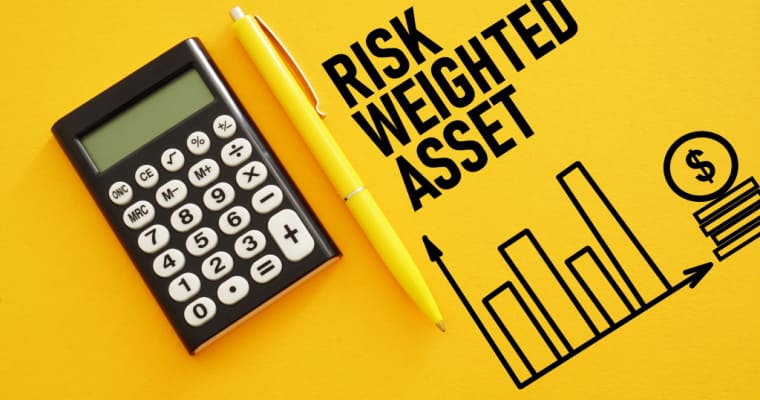Understanding Risk-Weighted Asset (RWA) and its Calculation in Banking

Risk-weighted asset or RWA is a banking term that refers to an asset classification system to determine minimum capital in reserve a bank needs to have to avoid insolvency.
Banks and other financial institutions who are into lending or investment business are always at risk regarding loan customer defaulting or investors flatlining. Minimum capital in reserve helps them mitigate the risks of filing for insolvency. Calculating risk-weighted assets helps banks figure out the total risk-weight of each of their asset classes.
This blog talks about how a risk-weighted asset is calculated, its advantages and whether it’s a foolproof method to minimise insolvency risks.
What are Risk-Weighted Assets?
Risk-weighted assets refer to a method used to identify the minimum amount of capital that a lending institution must have in order to avoid insolvency and protect its depositors and investors.
Imagine a see-saw. If there’s a very heavy individual at one end, you would automatically seat an equally heavy individual at the other end (or maybe two light individuals) to maintain a balance. If not, the heavier side will struggle to rise off the ground.
This analogy serves to illustrate how (RWA) risk-weighted assets work.
If a bank makes a lending move that is heavy on credit risk on one end, the bank needs to ensure that they hold a correspondingly large sum of capital on the other.
That way, if the heavy-risk deal results in bad debt, the bank still holds enough capital to stay afloat and pay back its depositors.
For example, an unsecured loan is far riskier than a secured loan because, in the case of the secured loan, the lending institution can go ahead and sell the collateral in order to regain its capital if the borrower fails to repay.
Similarly, a corporate bond has a higher credit risk than a government bond because the government will typically repay all its debts on account of the fact that it has a reliable income from taxpayers that can be used for debt repayment.
In a way risk-weighted assets may as well be called credit risk-weighted assets because the risk in question is specifically credit risk.
Risk-Weighted Assets Formula
There are 2 possible formulas for risk-weighted assets calculations:
Option 1: If you have the capital adequacy ratio available use this RWA formula:
Risk-weighted assets = (Tier 1 + Tier 2 Capital) ÷ capital adequacy ratio
RWA example with this RWA formula:
Let’s look at Bank XYZ with a capital adequacy ratio of 8
| Details | Figures |
| Tier 1 capital | 10,00,000 |
| Tier 2 capital | 25,00,000 |
| Total | 35,00,000 |
| RWA (using formula (Tier 1 + Tier 2 Capital) ÷ capital adequacy ratio) | 437,500 |
Option 2: If you do not have the capital adequacy ratio handy, use this risk-weighted assets calculation method:
- Step 1: Measure the risk of every asset belonging to the bank/ financial institution in focus
- Step 2: Add the values
The resulting figure is the total RWA or total risk-weighted asset of the financial institution.
RWA example with this second risk-weighted assets calculation method:
| Asset | Amount (Rs) | Risk weight (%) | RWA (risk weighted asset) |
| Cash | 200, 00,000 | 0 | 0 |
| Government of India Bonds | 100,00,000 | 0 | 0 |
| Housing loans | 400,00,000 | 35 | 140,00,000 |
| Business loans | 300,00,000 | 100 | 300,00,000 |
| Total | 1,000,00,000 | 440,00,000 |
How to Assess Risk?
So how is risk weight – or percentage of risk- for each asset determined?
There are several factors that may influence the risk weight, depending on the type of asset.
Let’s say the bank has invested in a treasury bill or a Government of India bond (like in our table above) – this will come with little or no risk because of the government’s ability to return its dues since it enjoys a steady tax income.
On the other hand, in the case of a business loan, one would look at the borrower’s credit history – do they typically pay dues on time? Regulators will also take into consideration the value of the collateral. For example, if the business has offered its machinery as collateral against the loan, the value and saleability of the machinery would determine the risk weight allocated to the asset).
If the bank has signed off a loan to a construction company for a housing project, key considerations would be the potential earnings from the sale of homes.
Also Read
Rule Set-up of Risk-Weighted Assets
The rules for placing assets into various risk buckets are determined by a global framework known as the Basel III framework.
As the name suggests, the framework has witnessed two prior editions. The latest edition came into force after the 2008 crisis when it came to light that although two banks might display the same rupee/ dollar value of assets held, their holdings might represent different risk profiles (particularly credit risk) depending on what specific assets they held.
The current set of rules governing risk-weighted assets came about so that banks that hold riskier assets hold a larger amount of capital to pay depositors or investors back.
Here are two of the main rules of the Basel II framework
- The bank/ lending institution must bundle assets by risk category so that the amount of required capital is matched with the risk level of each asset type.
- Banks/ lending institutions may utilize credit ratings/ credit scores to determine an asset’s risk coefficient.
How are Risk-weighted Assets Calculated for Credit Risk?
Two main factors are considered in risk profile considerations:
1. Source of Repayment
For example, if the source of repayment is a salary and one is a contracted employee, the asset (in this case, the personal loan) would be less risky because this person is unlikely to lose their income and should be able to settle their dues on time.
On the other hand, if the source of repayment for the personal loan is income from a retail shop, this is a lot more unpredictable, and the asset would have a higher risk profile.
2. Value of Collateral
Collateral changes the game for a high-risk asset because the collateral can be sold to recover the capital. For example, if a bank extends a loan to a business against its office building, if the business is unable to repay the loan, the bank can sell the office building and recover its funds.
Assets linked to collateral that is of higher or equal value to the amount of the loan will typically have a lower credit risk.
Advantages of Risk-Weighted Assets
Here are some of the advantages of risk-weighted assets:
- Helps banks mitigate insolvency risk
- Helps banks identify assets that carry minimum or maximum risk
- Helps banks understand how much capital they would need in reserve
Disadvantages of Risk-weighted Assets
Some of the drawbacks include:
- Calculations might not always be accurate as the risk profile can change as the economy and markets are dynamic.
- The Basel III regulations might push banks to invest more cautiously than they would want to, resulting in potentially lower earnings (in the pursuit of lower risk because potential earnings are typically directly proportional to risk exposure).
- The concept of RWA allows banks to assess their own risk but they might not be able to do so without bias since admitting to higher risk affects the bank negatively (they need to retain a higher amount of capital, for example).
Also Read
Final Word
As an investor, you should definitely care about a financial institution’s risk-weighted assets and capital adequacy ratio. This is because, whether you are investing in banking stocks or taking a low-risk route and investing in fixed deposits, the bank’s credit risk could impact you.
A bank with high-risk assets and a low capital adequacy ratio is typically a more high-risk investment proposition than a bank with low-risk assets and a high capital adequacy ratio.
FAQs
Ans. “Better” is a subjective term. RWA (risk-weighted assets) gives you an idea of how heavily a bank invests in high-risk assets.
Ans. Assets refer to anything that could deliver earnings to a bank. That might include its own office buildings, but also refers to stock market instruments. Bonds, for example, have the potential to deliver earnings to the bank and therefore come under assets. However, there is credit risk involved because the bond-issuer might run into capital problems and fail to pay back bond-holders.
Ans. In a way, yes, that is the whole idea of RWA and the capital adequacy ratio. Banks can pursue potentially higher returns by increasing their risk exposure, while at the same time retaining adequate capital to pay investors back, should the high-risk investments fail to deliver the expected returns.
The fundamentals of this are very similar to investment advisors telling investors that if they intend to increase their exposure on the stock market, they should have a steady income and sufficient capital in hand to look after their basic living expenses.
That said, you should also look at other metrics and indicators linked to the bank, and the overall stock market. Some questions you need to ask include: Is now a good time to invest in banking stocks? Are the prices inflated? What is the banking stock’s PE ratio?
There is no one-size-fits-all answer for anything stock market related, but yes, RWA is a way to cover one of your bases.
Disclaimer
This article is solely for educational purposes. Navi doesn't take any responsibility for the information or claims made in the blog.

Customer’s Feedback
No comments found.10 Best Bank for Savings Account in India [Highest Interest Rate 2023]
Savings account is a type of financial instrument offered by several banks. It lets you safely depo... Read More »What is Issuer Identification Number (IIN)- Working and Importance
What is an Issuer Identification Number (IIN)? Banks and financial institutions assign a distinc... Read More »What is a Vostro Account – Meaning, Working and Difference
What is a Vostro Account? A Vostro account is a bank account held by a domestic bank on behalf o... Read More »What is a Solvency Certificate? – Format, Documents Required & How to Apply Online?
What is a Solvency Certificate? A solvency certificate is a legal document furnishing the detail... Read More »What is Merchant Banking – Services, Features, Functions and Example
What is Merchant Banking? Merchant banking is a set of select banking and financial services off... Read More »Automated Clearing House: Objectives, Types and Process
Automated Clearing House is an electronic fund transfer network that manages automatic and direct... Read More »How to Redeem Credit Card Reward Points ?
Credit Card Reward points are types of incentives that customers receive when they use a credit car... Read More »What is Electronic Clearing Service (ECS) in Banking and How does it Work?
What is Electronic Clearing Service (ECS)? Electronic Clearing Service (ECS) is a method of elec... Read More »What are Credit Card Validators and How to Use them?
What is a Credit Card Validator? A credit card validator is a tool that checks the validity of a... Read More »What is Cash Management and How Does it Work?
Managing available capital can make sure that a small business stays afloat. Cash management is an ... Read More »What are Prepaid Expenses? – Definition, Examples, and Journal Entry
Prepaid expenses represent payments made in advance for products or services expected to be incurre... Read More »Increase Credit Card Limit – Important Tips and How to Do It?
The credit card limit is the maximum amount of money you can spend using your credit card. Your cre... Read More »Top 10 Chit Fund Schemes in India in 2023
Chit funds are one of the most popular return-generating saving schemes in India. It is a financial... Read More »10 Best Gold ETFs in India to Invest in April 2023
Gold ETFs or Gold Exchange Traded Funds are passively managed funds that track the price of physica... Read More »10 Best Demat Accounts in India for Beginners in 2023
Creation of Demat accounts revolutionised the way trades were conducted at the stock exchanges. It... Read More »20 Best Index Funds to Invest in India in April 2023
What is an Index Fund? An index fund is a type of mutual fund or exchange-traded fund (ETF) that... Read More »Best Arbitrage Mutual Funds to Invest in India in April 2023
Arbitrage funds are hybrid mutual fund schemes that aim to make low-risk profits by buying and sell... Read More »10 Best SIP Plans in India to Invest in April 2023
What is SIP? SIP or Systematic Investment Plan is a method of investing a fixed amount in ... Read More »10 Best Corporate Bond Funds in India to Invest in April 2023
Corporate bond funds are debt funds that invest at least 80% of the investment corpus in companies ... Read More »10 Best Bank for Savings Account in India [Highest Interest Rate 2023]
Savings account is a type of financial instrument offered by several banks. It lets you safely depo... Read More »

































